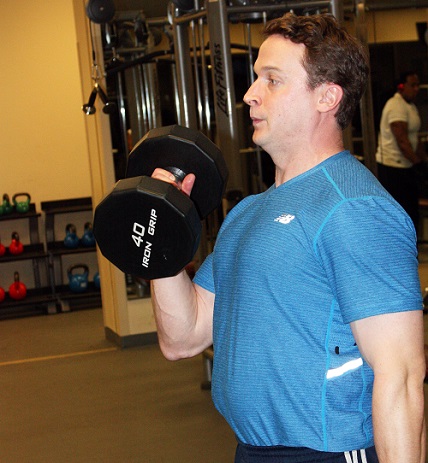Recommended Content:
Physical Activity | Nutrition
At the start of the New Year many people make resolutions to improve their wellness, focusing on good nutrition, exercise, mental health, a tobacco-free lifestyle and adequate sleep. Enthusiasm often wanes after a few weeks, however, if SMART goals are not set.
"People may set unrealistic or complicated goals for themselves, but goals should be SMART – Specific, measureable, attainable, realistic and time-bound," said Travis Combest, exercise physiologist and personal trainer in Outpatient Nutrition Services at Walter Reed National Military Medical Center.
Combest explained SMART goals build momentum, as well as confidence leading to improvements in fitness and nutrition. These goals can include simply bringing a packed gym bag to work and going to the fitness center at lunch-time three times a week for a brief workout, walking the track or bringing a plastic bag packed with celery and oranges for a light snack during mid-day three days a week, he said.
A good pair of running shoes and workout clothes are all people need to begin a simple exercise program, Combest said. He added for those who may want to do their fitness at home, an exercise mat, stability or exercise ball, and a set of dumbbells ranging from five to 20 pounds, depending on strength level, are good to have on hand.
For people who enjoy working out in groups, Combest recommended classes such as spin, dance fitness, yoga, cross fitness or even basic weight training, most of which are offered in military fitness center.
 People can implement some muscular conditioning exercises, such as abdominal crunches, squats or shoulder presses to build up muscular strength. (U.S. Army photo by Bernard Little)
People can implement some muscular conditioning exercises, such as abdominal crunches, squats or shoulder presses to build up muscular strength. (U.S. Army photo by Bernard Little)"If possible, find a buddy to work out with for motivation," Combest added. "Also, if you have a trackable exercise device, you should wear that to motivate you to move more."
Combest said people who haven't exercised in a while should first consult a physician and begin their regimen gradually. "Even 10 minutes of exercise at a time counts. Build and add variety to your routine every two or three weeks. For example, if you are walking on the treadmill, maybe switch and use the elliptical equipment, adding minutes going up from 10 to 20 minutes, or increasing the intensity, such as going from level 3 to level 4."
Combest said it's also important to do some form of an aerobic exercise and stretch to maintain flexibility. Walking, yoga, jumping jacks or riding a stationary bike and stretching the back of your leg (hamstring), are good examples. He added walking is not only good for fitness, but mental health as well.
"Next, implement some muscular conditioning exercises, such as abdominal crunches, squats or shoulder presses to build up your muscular strength," he added.
Ideally, people should exercise 30 to 60 minutes at least three to five days a week for general fitness, Combest continued. "For weight loss, increase your duration to 45 to 74 minutes, four to six days per week. Perform some muscular-conditioning exercises that work on muscle groups, including the abdomen, back, shoulders, chest and legs at least two days a week on opposite days to let muscles rest.
Regarding nutrition, Army Capt. Paul Rosbrook, a registered dietitian and chief of Outpatient Nutrition Services at WRNMMC, said, "When making goals for your diet, focus on changes for a day to a week at a time. For example, don't say, 'I will not eat chocolate this year.' This is a flat goal that is easy to fail. Instead, say, 'I will not eat chocolate today or this week, and progress daily and weekly with that continued goal."
Rosbrook also encourages people to attend a nutrition class or lecture, join a support group, social media community, or other external group to help with accountability. "Download and track your food using a digital phone or computer application. If you continue to struggle with diet changes, make an appointment with a registered dietitian who can help fine-tune your diet for long-term success."
He also recommends people follow the U.S. Department of Agriculture's MyPlate model.
"Fill half of your plate with non-starchy vegetables, such as mushrooms, cauliflower, carrots, tomatoes, and leafy greens before plating the rest of your food," Rosbrook explained. "This will keep calories low, as well as help you feel full and provide numerous phytonutrients, vitamins, and minerals.
"Also, portion your starches, such as rice, beans, potatoes, pasta and corn to a half of a cup and no more than 1 cup per meal," he added. "Keep meat portions at 3 to 4 ounces, or the size of a deck of cards. Most restaurants serve 6 to 8 ounces of meat, which can provide 150 to 300 more calories than a necessary portion, which when consumed twice per day equates to 300 to 600 more extra calories daily," Rosbrook added.
Combest and Rosbrook agreed water is also important for hydration during exercise and good diet.
"Remaining hydrated enables you to exercise longer and at higher intensity during your workouts," said Combest. "Water is also key for proper nutrient metabolism. Drinking water during meals is also a great way to be, and stay, full longer, so it can help with weight management," he added.
"Most of what we accomplish in life is due to planning," Combest added. This applies to exercise and nutrition as well. Make sure to make time to exercise and learn to say 'no' to things that disrupt this time," Combest added.
Disclaimer: Re-published content may have been edited for length and clarity. Read original post.